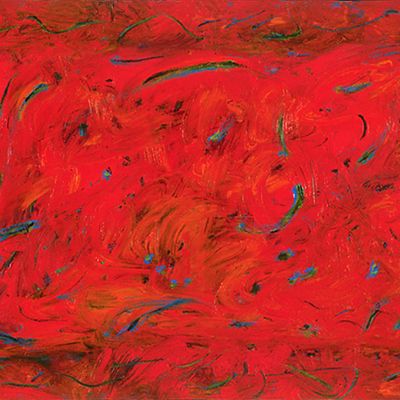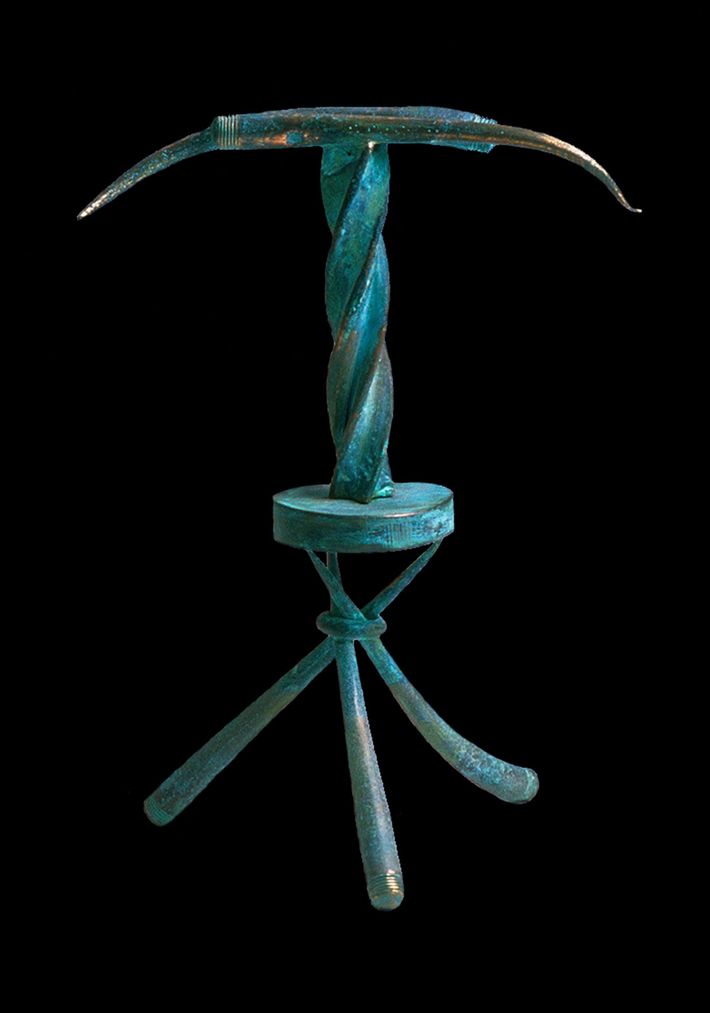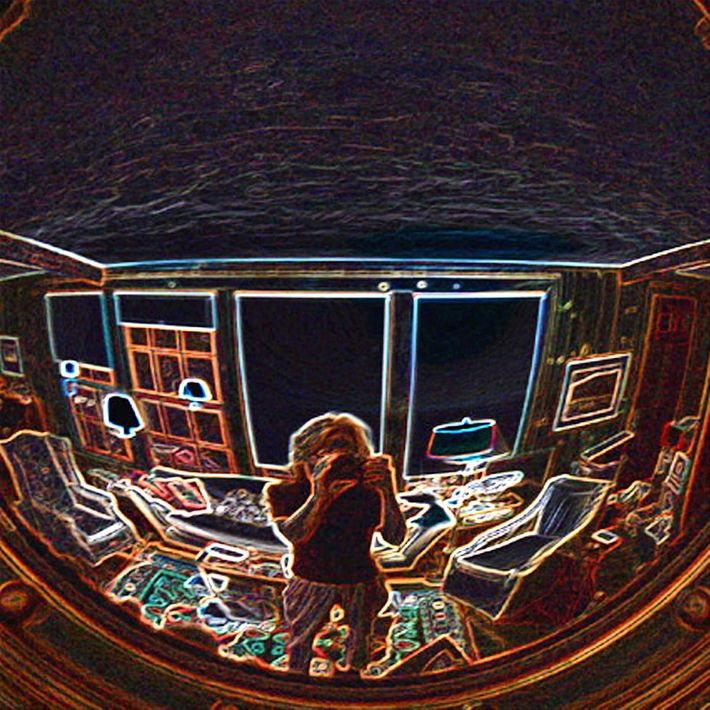
For most people, a bad toothache feels like a persistent throb or a sharp pain. But without a dentist visit, there’s no way to tell whether it warrants a root canal. A synesthete, however, might wake up one morning and see the tooth glowing orange. For Manhattan-based artist and co-founder of the American Synesthesia Association Carol Steen, physical discomfort manifests as color (usually, a bright chrome orange). And in Steen’s case, much to her dentist’s surprise, she was able to diagnose a dying nerve before any clinical signs of tooth damage.
The word synesthesia means “union of the senses,” and synesthetes — roughly 4 percent of the population — are adults whose senses mingle in a sort of cross-wiring of the brain. Based on self-reporting and scientific case studies so far, there appear to be 80 varieties of these involuntary sensory perceptions. Shapes and sounds can have particular tastes, while letters or numbers can embody distinct personalities and genders. To take examples based on scientific literature, for one synesthete, the sound of a high C on a trumpet induces a flash of Ferrari red. For another, eating chocolate-covered raisins causes a sensation in the fingertips. For a synesthete with “ordinal-linguistic personification,” the number 9 might be a bearded hipster, while someone else swears 9 is a high-ponytailed blonde. It’s that idiosyncratic. Greta Berman, a Juilliard art historian who studies synesthetic artists, explains synesthetes don’t just think 9 is this or that. They know it is, and they will “fight to the end” that a number has a certain persona or is a specific shade. For Steen, five is cadmium yellow medium. Though her father, also an artist, insisted five was yellow ochre. And like most with synesthesia, Steen can’t recall “5” ever being a different hue or not having joined senses.
These days, so many celebrities seem to be proclaiming their synesthesia, it feels, as best-selling novelist and radio host Kurt Andersen references in one of his Studio 360 podcasts, like a kind of neurological “humblebrag.” Kanye has it. So does Beyoncé. And Lady Gaga’s got it, too.
In fact, a growing body of evidence shows synesthesia is more common among creative types and that some of the most imaginative minds — Hockney, Kandinsky, Nabokov — were indeed synesthetic. According to those who study the condition, cross-sensory experiences may offer a particular artistic advantage: a greater aesthetic sensitivity than the rest of us, and thus a greater likelihood to gravitate toward artistic fields. After all, synesthetes are able to express seemingly unrelated concepts in a variety of mediums: numbers with personalities, colors with pain, moving shapes with sound. And unlike their colleagues, synesthetic artists — those who use their neurological trait as a foundation of their practice — respond intuitively to what Steen calls the “multimedia-like stimuli” going on around them. An “ordinary” painter either captures a landscape before her or something she imagines. A synesthetic one paints what she actually visualizes when hearing a specific concerto — or as Steen explained, what she sees when she feels the jab of a tetanus shot.
“There are times when the vision I have is great and I can’t wait to run home to paint what I’ve seen,” said Steen, who is known for incorporating her synesthesia in her art. Her abstract painting Full View is what she perceived when her acupuncturist removed the needles at the end of a session. Still, not everything she experiences is “synesthetically wonderful.” “I assure you that if I smell something really bad,” she explained, “it’s not anything anyone would want to see.” Steen describes the reaction as an immediate physical response. In fact, she listens to music when she goes to the art-supply store, carefully removing the paint-tube cap to see if the color matches the sound she’s hearing.

But until fairly recently, synesthesia had its share of skeptics. In 1980, according to George Washington University neurologist Dr. Richard Cytowic, synesthetes were still often dismissed as “looking for attention” or just “speaking metaphorically,” such as “bitter cold” or “loud tie.” In his book, Wednesday Is Indigo Blue: Discovering the Brain of Synesthesia, Cytowic recalls how colleagues joked about his research subject, Michael, who “claimed” he felt intense flavors running down his arm. According to them, Michael was either “crazy” or “on drugs.” Synesthesia couldn’t be real, because it contradicted the dominant scientific paradigm that senses travel along five separate channels.
Since then, the science of synesthesia has come a long way, thanks to neuroimaging and the ability to connect somebody’s sense of the reality of the world to her brain’s architecture. A person no longer has to “claim” that Wednesday is indigo blue; researchers can compare activity between her cortical areas when she sees the word to a non-synesthete’s brain scan. To take a handful of studies, there’s now a known genetic link in families, as well as a neurological basis for the most common form of synesthesia, “grapheme-color,” when numbers and letters have distinct colors. A 2013 paper in Cerebral Cortex also identified a neural link between feeling and hearing, showing that in rare instances, synesthesia can also be acquired after a stroke. Using MRI, neuroscientists found that, indeed, the body can “mix up” sound and touch even without brain damage.
“We all have a little bit of synesthesia,” said Tony Ro, CUNY Graduate Center professor of psychology and the article’s lead author. Nails on a chalkboard make us cringe; a buzzing mosquito makes us itch. But today, Ro explained, scientists understand the anatomical basis for the seemingly random reactions, and how synesthetes have greater neural crosstalk than the rest of us. Still, for most people, it’s nearly impossible to grasp what intertwined senses are like; how it feels to live with chromesthesia — the “sound-to-color” that Steen has — or her experience of “colored pain.” But at least artists like Steen provide some visual equivalence for non-synesthetes. Steen works in three dimensions, too. Her twisted bronze and steel blue sculpture, Cyto, conveys the shapes and color of the first two syllables of Dr. Cytowic’s name. Even today, the synesthesia community feels tight-knit. In 1993, after hearing Dr. Cytowic on the radio, Steen reached out to discuss her synesthesia, which she’d kept hidden for decades. They soon became friend-colleagues, and she gifted him Cyto as thanks for giving her “knowledge” and “freedom.”
Photographer Marcia Smilack is also known for using synesthesia as a cornerstone of her process. As a “reflectionist” — her term of art — Smilack takes trippy pictures of the ocean’s surface the moment she has a synesthetic reaction, some of which have a Screamesque quality to them. And Smilack appreciates the comparison, feeling an uncanny connection to Edvard Munch, and the “sound waves” she sees in his famous, distorted images. (Incidentally, Berman thinks Munch might’ve been a synesthete too.) “I think of my work as painting by camera,” Smilack explained. “The colors I see are more like colored light than paint pigment.” For example, Cello Music illustrates Smilack’s auditory perceptions of reflections one night, off moving water. “I aimed my camera at the source and clicked the shutter the moment I felt satin against my skin,” she said.

At the same time, synesthesia can lead artists awry. Sean Day is a musician who sees shapes, movements, and colors when he hears timbres. For 20 years, he’s operated the Synesthesia List, an online forum, regularly cited by synesthesia experts and scientists. Day started scoring music in his early teens, composing by the colors he wanted to view and finding inspiration in fellow-synesthete Duke Ellington. In college, however, Day realized his synesthesia was actually hurting his creativity. “I focused way too much on my synesthetic colors,” he wrote in an essay for Oxford’s Handbook of Synesthesia. “I was ignoring what I was learning about balancing orchestration,” Day explained, “and my music sometimes was ludicrous, like mandolins and bagpipes.”
So, by his mid-30s, when writing music, Day started either ignoring his synesthesia completely or, if the piece called for a solo, focusing only on that one color or texture, without trying to combine instruments. Synesthesia does not make you a better artist, he said (emphatically and multiple times). Synesthetes are just as likely to be “crappy untalented musicians” as anybody else. Excellence in any art form comes from talent, practice, and mastery — not from having different sensations as most people. But, he clarified, if music makes you see colors and shapes, you might be more likely to pick up a guitar or sit at a piano in the first place — since music feels so multilayered.
A survey of 358 fine-arts students at three large universities, published by the Creativity Research Journal in 1989, suggests synesthetes are more common on artistic turf. Twenty-three percent of respondents experienced synesthesia in a “spontaneous and consistent mater”— over five times expected in the general population. The study also found that synesthetes scored significantly higher on four standardized creativity measures. For example, they had a mean score of 38.4 (40 being the creative gold standard, 20 the norm) on the Barron Welsh Art Scale, which asks respondents to “like” or “dislike” 86 designs, specially selected to distinguish between the typical judgments of artists and nonartists. As Dr. Cytowic describes, synesthetes see the similar in the dissimilar (music and color; pain and color; syllables and shapes), and people who excel at making metaphors are generally more creative. “But far greater in number than famous artists who happen to be synesthetic, “ he said, “are ordinary synesthetes who happen to be skilled in literary arts, paintings, or playing a musical instrument.”

And creativity has many guises. Marcos Lutyens is a cutting-edge artist who stages “perceptual interventions” at museums like Paris’s Centre Pompidou and the Los Angeles County Museum of Art. He uses hypnosis and performance to challenge the way viewers respond to stimuli, and has worked with synesthetes, especially, to examine how they perceive reality. In San Francisco, Lutyens sent a group of individuals with synesthesia to McDonald’s — the most ubiquitous American place he could imagine. One participant, who experiences words as color, said the Golden Arches symbol is “wrong” because it should be “red.” For another, the kitchen equipment sounds “shuddered [her] neck and back in a softer, indescribable kind of shock.” “What we classify as artistic,” Lutyens said, “is just normal to them.” And artists with synesthesia work outside of traditional venues, too. For instance, Lutyens describes how an award-winning mixologoist, a synesthete based in Manchester, England, Jody Monteith, mixes the color of drink flavors to “tap into the perfect taste.”
“Do synesthetic artists have a common way of seeing even when they aren’t consciously using synesthesia in their process?” asked Greta Berman, who co-curated (with Steen) the 2008 exhibit, Synesthesia: Art and the Mind, at the McMaster Museum of Art in Hamilton, Ontario. According to the show’s catalogue, she (and Steen) brought four recognized, “genuine” synesthetes together for the first time: David Hockney, Joan Mitchell, Marcia Smilack, and Carol Steen. Based on personal writing and his oeuvre, Berman suspects van Gogh was a synesthete too.
“Here’s the difference,” Berman said. “I don’t think Monet had synesthesia. He’s trying to reflect a physical scene, looking directly at a landscape, and not a sensory vision he had.” As an indication of synesthesia, Berman often searches artwork for “Kluver’s form constants”— geometric patterns (often lattice or spider-web-like), discovered by psychologist Heinrich Kluver in the 1920s, which regularly appeared during peyote hallucinations and synesthetic perception. “Anyone looking at paintings by van Gogh, Charles Burchfield, Wassily Kandinsky, and David Hockney, for example, will surely observe these form constants repeatedly,” according to Berman and Steen’s essay in Oxford’s Handbook on Synesthesia.
Yet the true power of synesthetic art may lie in what the 96 percent of us who are non-synesthetes can gain from it. “Synesthesia shows you how different sensory perception can be for everyone,” said Day. He calls it a lesson in “neural diversity” and that synesthetic art “strives towards a new understanding” of what’s “normal” for the human brain. Normal, he explains, is diverse. On the humanist side, Dr. Cytowic said in an email, synesthetic studies affirm subjective points of view: how two people can see the same “objective” thing quite differently — each equally valid — in a time “when citizens are becoming increasingly polarized.“
Most of us will never hear colors or taste shapes. But it is pretty common for a non-synesthete to get chills during an operatic crescendo or the high notes of the “Star-Spangled Banner,” or standing in the Sistine Chapel. These are dual-sensory experiences — auditory, visual, and physical stimulation — but more importantly, a way of deeply inhabiting a moment in time and the world more richly, which is, in the end, what it means to have a genuine connection to art.




